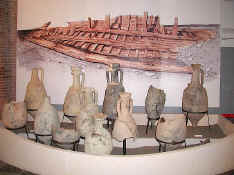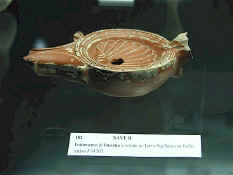The origins of Pisa and Etruscan PisaNeolithic remains indicate that the mouth of the Arno was settled in very early
times and most likely Ligurian colonists of Celtic origin settled here. We know
that Pisa was a port of call for the Greeks and the legend of Pelops, who left the
banks of the Alpheo, a river in the Peloponnese, for those of the Arno to found a new
Pisa is possibly supported by Virgil in the 10th book of the Aeneid.
Roman PisaAs Etruria was romanised, Pisa grew in importance and was an ally of Rome in the long wars against the Ligurians and the Carthaginians. The port (Portus Pisanus), situated between the mouth of the river (at that time near where San Piero a Grado stands today) and that portion of the coast now occupied by Livorno, constituted an ideal naval base for the Roman fleet in its expeditions against the Ligurians and the Gauls, and in the operations aimed at subjugating Corsica, Sardinia and various coastal zones of Spain. Pisa, as an ally of Rome, then became a colonia, a municipium and in the time of Octavianus Augustus (1st cent. B.C.) was known as Colonia Julia Pisana Obsequens. In the meanwhile the growth in population, the development of shipbuilding and trade - fostered by the establishment of the Via Aurelia and the Via Aemilia Scaurii as well as by the harbour - resulted in an expansion of the inhabited area which was soon surrounded by walls.
The imperial period was noted for the magnificence of its public and private buildings. Although now traces of Roman life in Pisa are scarce (Baths of Hadrian, improperly called the 'Baths of Nero', capitals from the age of Severus, 3rd century A.D.), there were probably a forum and a palatium as well as an amphitheatre, public baths, a naval base and numerous temple structures, replaced by churches in Christian times. In 1991, excavations carried out near the Arena Garibaldi revealed the presence of an Etruscan necropolis on which a domus augustea was laid out in Roman times. Mediaeval Pisa and the rise of the Maritime RepublicLegend has it that the first Christian influences were introduced into the area of Pisa by Saint Peter himself, who landed
'ad Gradus' in 47 A.D.
and a basilica was subsequently built there. With the fall of the Roman Empire, Pisa passed first under the
Lombards and then under the Franks. In the early Middle Ages, the city's maritime
ambitions burgeoned and
Pisa soon came into conflict with the Saracens, who were aiming at full supremacy of the Mediterranean. With bases in Corsica and Sardinia, they frequently threatened the lands controlled by the Church itself. The story of Kinzica de' Sismondi
is set in this period. This young
Pisan heroine is said to have saved the city from a Saracen incursion while most of the Pisan army and fleet were out driving the
moslem infidels from Reggio Calabria (1005).
Guelphs and Ghibellines
The disastrous consequences of the war on land against the Guelphs and the burdensome conditions consequently imposed by the Florentines (1254), and in particular the collapse of the Ghibelline ideal, were paralleled by events on sea: in the fateful waters of the Meloria on August 6, 1284, the day of St. Sixtus, a date up to then propitious for the Republic, an astute naval
manoeuvre of the preponderant Genoese fleet, commanded by Oberto Doria, wiped out the Pisan galleys, under the command of the Venetian Alberto Morosini and Andreotto Saracini. It was absolutely impossible
for Count Ugolino della Gherardesca, who was defending the port of Pisa, to come to the aid of the fleet, which suffered heavy losses, and at least 10,000 prisoners were taken. The subsequent attempt of Ugolino (who in the meanwhile had become podestà) to impose a neo-Guelph restoration in Pisa, ceding possession and castles to the eternal
Florentine, Luccan and Genoese rivals, earned him the undisguised hostility of the Ghibelline faction, and this together with
what had happened at Meloria, led to new accusations of betrayal. In March of 1289 the Ghibelline faction, with Archbishop Ruggeri degli Ubaldini at its head, prevailed, and Ugolino, with his children and grandchildren, was sentenced to die of starvation in the Torre dei Gualandi. In the meanwhile the peace of Fucecchio
(12 July 1293) imposed new and onerous conditions in favor of the Florentines, and the hopes aroused in Ghibelline Pisa by the
ephemeral episode of Henry VII of Luxenbourg was to no avail. With the advent of the podestà Uguccione della Faggiola,
a valorous Ghibelline condottiere, Pisa took its revenge, conquering Lucca (1314) and
dramatically defeating the Florentines and their Siennese and Pistoiese allies at Montecatini
(29 August 1315). Subsequently, the prevailing party struggles in the city (in which the philo-Florentine merchant faction headed by Gambacorti was long opposed to the anti-Florentine faction comprised of nobles and entrepreneurs, headed by the Gherardesca) led the Genoese to force the
harbour and carry off the chains, which they showed off as a trophy for many years (at present they are once again in Pisa, in the Camposanto). On the land front, the Florentines were once more victorious at Cascina
(28 July 1364). The fall of the Maritime Republic of Pisa and the rise of Medici suzeraintyThe signoria of
Piero Gambacorti seemed to inaugurate a period of relative peace and prosperity but his treacherous assassination
(21 October 1392) by hired killers instigated by the Visconti, delivered Pisa
into the hands of the lords of Milan. In 1405, they traded Pisa off to the Florentines for
money. The indignation and fierce resistance of the Pisans was weakened by a series of negative
events and in the end the city had to surrender after a siege. This episode (9
October 1406) marked the irreversible fall of the glorious Maritime Republic. The subsequent advent of the French king Charles VIII aroused new hopes of independence in the city but the Florentines hastened to gather under the walls of their
once invincible rival and again besieged it together with their allies. The indomitable resistance of the Pisans was so strong the Florentines even though of deviating the course of the Arno and called
in Leonardo da Vinci for this purpose, but the idea remained on paper, for Pisa, exhausted by famine, had to accept the Florentine signoria
(20 October 1509). The Medici government of
Cosimo I resulted in a renaissance in the city: university activity was
rationalised and augmented, various public offices were organised, and, most important, the Order of the Knights of St. Stephen was instituted (1561), bringing new lymph to the Pisan maritime traditions, and taking part in the epic naval encounter of Lepanto
(7 October 1571). In that circumstance the Christian fleet, the expression of a coalition of European powers (the papacy and Spain, Venice and the House of Savoy and still others), under the leadership of Don Juan of Austria, assisted by Gian Andrea Doria, Marcantonio Colonna, Ettore Spinola and
Sebastiano Veniero, wiped out the maritime power of the Ottoman Turks captained by
Mehemet Ali.
Modern PisaThe re-unification of Italy also involved the citizens of Pisa: on the unforgettable day of Curtatone and Montanara (28 May 1848), the volunteers and the university students, who had cut off the tips of their university caps in order to aim their guns better, wrote one of the most glowing pages of the first war of independence. The year 1860 marked the plebiscite adhesion to the Kingdom of Italy: two years later Pisa bestowed a warm welcome on Garibaldi who had been wounded on the Aspromonte. The most recent history of the city includes the devastating destruction of World War II and in 1966 the disastrous flood of the Arno resulted in the collapse of the Ponte Solferino and the partial destruction of the Lungarno Pacinotti. |


